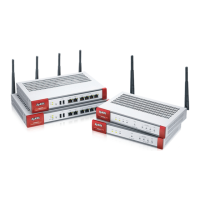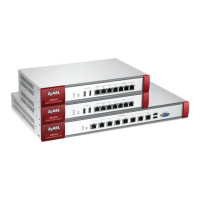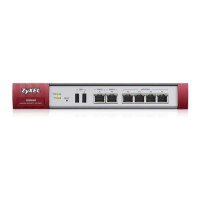Chapter 11 Routing
ZyWALL USG Series User’s Guide
410
Activate To turn on an entry, select it and click Activate.
Inactivate To turn off an entry, select it and click Inactivate.
Move To change a rule’s position in the numbered list, select the rule and click Move to display
a field to type a number for where you want to put that rule and press [ENTER] to move
the rule to the number that you typed.
The ordering of your rules is important as they are applied in order of their numbering.
# This is the number of an individual policy route.
Status This icon is lit when the entry is active, red when the next hop’s connection is down, and
dimmed when the entry is inactive.
User This is the name of the user (group) object from which the packets are sent. any means all
users.
Schedule This is the name of the schedule object. none means the route is active at all times if
enabled.
Incoming This is the interface on which the packets are received.
Source This is the name of the source IP address (group) object, including geographic address
and FQDN (group) objects. any means all IP addresses.
Destination This is the name of the destination IP address (group) object, including geographic and
FQDN (group) address objects. any means all IP addresses.
DSCP Code This is the DSCP value of incoming packets to which this policy route applies.
any means all DSCP values or no DSCP marker.
default means traffic with a DSCP value of 0. This is usually best effort traffic
The “af” entries stand for Assured Forwarding. The number following the “af” identifies one
of four classes and one of three drop preferences. See Assured Forwarding (AF) PHB for
DiffServ for more details.
Service This is the name of the service object. any means all services.
Source Port This is the name of a service object. The Zyxel Device applies the policy route to the
packets sent from the corresponding service port. any means all service ports.
Next-Hop This is the next hop to which packets are directed. It helps forward packets to their
destinations and can be a router, VPN tunnel, outgoing interface or trunk.
DSCP Marking This is how the Zyxel Device handles the DSCP value of the outgoing packets that match
this route. If this field displays a DSCP value, the Zyxel Device applies that DSCP value to
the route’s outgoing packets.
preserve means the Zyxel Device does not modify the DSCP value of the route’s outgoing
packets.
default means the Zyxel Device sets the DSCP value of the route’s outgoing packets to 0.
The “af” choices stand for Assured Forwarding. The number following the “af” identifies
one of four classes and one of three drop preferences. See Assured Forwarding (AF) PHB
for DiffServ for more details.
SNAT This is the source IP address that the route uses.
It displays none if the Zyxel Device does not perform NAT for this route.
Apply Click Apply to save your changes back to the Zyxel Device.
Reset Click Reset to return the screen to its last-saved settings.
Table 137 Configuration > Network > Routing > Policy Route (continued)
LABEL DESCRIPTION

